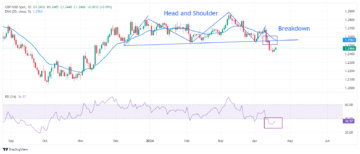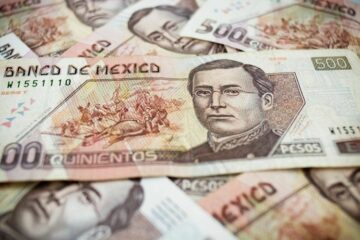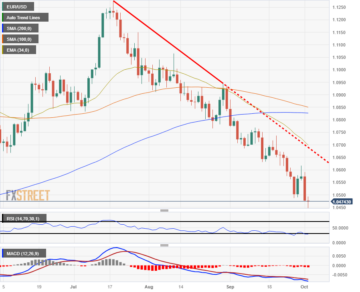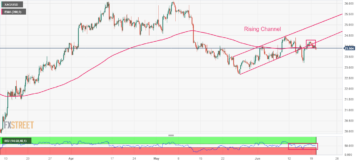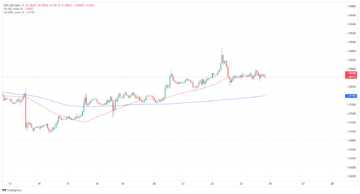
- Gold price meets with a fresh supply on Monday and snaps a two-day winning streak.
- Reduced bets that the Fed will cut rates in March act as a headwind for the XAU/USD.
- Retreating US bond yields, softer USD and geopolitical risk could limit deeper losses.
Gold price (XAU/USD) comes under renewed selling pressure on the first day of a new week and stalls a two-day-old recovery from the vicinity of the $2,000 psychological mark, or over a one-month low touched last Wednesday. The upbeat US macro data released last week pointed to a still resilient economy and gives the Federal Reserve (Fed) headroom to keep interest rates higher for longer. Adding to this, hawkish comments by several Fed officials forced investors to continue scaling back their expectations for a more aggressive policy easing in 2024, which, in turn, is seen undermining the non-yielding yellow metal.
Apart from this, a generally positive tone around the equity markets further contributes to the offered tone surrounding the Gold price through the first half of the European session. That said, a further escalation of geopolitical tensions in the Middle East, along with persistent worries about slowing economic growth in China, could lend some support to the safe-haven XAU/USD. Furthermore, a modest pullback in the US Treasury bond yields keeps the US Dollar (USD) bulls on the defensive, which might hold back bearish traders from placing aggressive bets around the XAU/USD and help limit deeper losses.
Daily Digest Market Movers: Gold price edges lower as traders trim bets for March Fed rate cut
- Reduced bets for an early interest rate cut by the Federal Reserve, along with a generally positive risk tone, prompt fresh selling around the Gold price on the first day of a new week.
- The better-than-expected US macro data released last week, along with the recent comments by Fed officials, force investors to further trim their bets for an early interest rate cut.
- The University of Michigan’s preliminary survey showed that the US Consumer Sentiment Index rose from 69.7 in December to 78.8 this month, or the highest level since July 2021.
- According to CME Group’s Fed Watch Tool, traders are now pricing in a less than 50% chance of a Fed rate cut move at the March policy meeting, down from over 70% last week.
- Chicago Fed President Austan Goolsbee said on Friday that the central bank needs more inflation data in hand before any decision could be made to cut interest rates.
- Separately, San Francisco Fed President Mary Daly said there is still a lot of work left to do on inflation and it is premature to think that rate cuts are around the corner.
- The US launched an attack on a Houthi anti-ship missile on Sunday, its seventh round of strikes since the Iran-backed rebel group began targeting merchant vessels in the Red Sea.
- There have been at least 140 attacks on US bases since October 17 and seven in the past week, including the heavy military strikes on Ain al-Assad base in Iraq, which injured US and Iraqi soldiers.
- Iran has vowed retaliation for a strike that killed five senior military officials in Damascus yesterday, an attack it blamed on Israel, which has neither confirmed nor denied involvement.
- Israeli forces and Hamas fighters clashed in several places on Sunday, while Israeli planes resumed heavy bombing on Khan Younis in the southern Gaza Strip.
- Israeli Prime Minister Benjamin Netanyahu appeared to rule out the two-state solution to the conflict and said that Israel must retain security control over all the territory west of Jordan.
- The People’s Bank of China (PBoC) decided earlier this Monday to leave the one-year and five-year Loan Prime Rate (LPR) unchanged at 3.45% and 4.20%, respectively.
Technical Analysis: Gold price flirts with $2,020 support, seems vulnerable to decline further
From a technical perspective, some follow-through below the $2,020 support will expose the $2,000 psychological mark, or over a one-month low touched last week. The latter should act as a key pivotal point, which if broken decisively could make the Gold price vulnerable. The subsequent downfall has the potential to drag the XAU/USD further towards the $1,988 intermediate support en route to the 100-day Simple Moving Average (SMA), currently around the $1,972 area and the 200-day SMA, near the $1,964-1,963 region.
On the flip side, Friday’s swing high, around the $2,040-2,042 supply zone, might continue to act as an immediate strong barrier. A sustained strength beyond could trigger a short-covering rally and lift the XAU/USD towards the $2,077 area. The upward trajectory could extend further and allow bulls to reclaim the $2,100 round-figure mark.
US Dollar price today
The table below shows the percentage change of US Dollar (USD) against listed major currencies today. US Dollar was the strongest against the .
| USD | EUR | GBP | CAD | AUD | JPY | NZD | CHF | |
| USD | -0.12% | -0.14% | 0.02% | -0.04% | -0.17% | -0.11% | -0.07% | |
| EUR | 0.12% | -0.01% | 0.14% | 0.08% | -0.05% | 0.01% | 0.06% | |
| GBP | 0.14% | 0.01% | 0.14% | 0.10% | -0.03% | 0.03% | 0.07% | |
| CAD | -0.01% | -0.12% | -0.14% | -0.04% | -0.17% | -0.10% | -0.07% | |
| AUD | 0.04% | -0.08% | -0.10% | 0.04% | -0.12% | -0.06% | -0.01% | |
| JPY | 0.16% | 0.04% | 0.06% | 0.15% | 0.14% | 0.07% | 0.10% | |
| NZD | 0.10% | -0.02% | -0.04% | 0.11% | 0.06% | -0.06% | 0.04% | |
| CHF | 0.06% | -0.06% | -0.07% | 0.06% | 0.02% | -0.11% | -0.05% |
The heat map shows percentage changes of major currencies against each other. The base currency is picked from the left column, while the quote currency is picked from the top row. For example, if you pick the Euro from the left column and move along the horizontal line to the Japanese Yen, the percentage change displayed in the box will represent EUR (base)/JPY (quote).
Gold FAQs
Gold has played a key role in human’s history as it has been widely used as a store of value and medium of exchange. Currently, apart from its shine and usage for jewelry, the precious metal is widely seen as a safe-haven asset, meaning that it is considered a good investment during turbulent times. Gold is also widely seen as a hedge against inflation and against depreciating currencies as it doesn’t rely on any specific issuer or government.
Central banks are the biggest Gold holders. In their aim to support their currencies in turbulent times, central banks tend to diversify their reserves and buy Gold to improve the perceived strength of the economy and the currency. High Gold reserves can be a source of trust for a country’s solvency. Central banks added 1,136 tonnes of Gold worth around $70 billion to their reserves in 2022, according to data from the World Gold Council. This is the highest yearly purchase since records began. Central banks from emerging economies such as China, India and Turkey are quickly increasing their Gold reserves.
Gold has an inverse correlation with the US Dollar and US Treasuries, which are both major reserve and safe-haven assets. When the Dollar depreciates, Gold tends to rise, enabling investors and central banks to diversify their assets in turbulent times. Gold is also inversely correlated with risk assets. A rally in the stock market tends to weaken Gold price, while sell-offs in riskier markets tend to favor the precious metal.
The price can move due to a wide range of factors. Geopolitical instability or fears of a deep recession can quickly make Gold price escalate due to its safe-haven status. As a yield-less asset, Gold tends to rise with lower interest rates, while higher cost of money usually weighs down on the yellow metal. Still, most moves depend on how the US Dollar (USD) behaves as the asset is priced in dollars (XAU/USD). A strong Dollar tends to keep the price of Gold controlled, whereas a weaker Dollar is likely to push Gold prices up.
- SEO Powered Content & PR Distribution. Get Amplified Today.
- PlatoData.Network Vertical Generative Ai. Empower Yourself. Access Here.
- PlatoAiStream. Web3 Intelligence. Knowledge Amplified. Access Here.
- PlatoESG. Carbon, CleanTech, Energy, Environment, Solar, Waste Management. Access Here.
- PlatoHealth. Biotech and Clinical Trials Intelligence. Access Here.
- Source: https://www.fxstreet.com/news/gold-price-drifts-lower-as-traders-continue-to-trim-bets-for-an-early-rate-cut-by-the-fed-202401220417
- :has
- :is
- $UP
- 000
- 1
- 100
- 17
- 2021
- 2022
- 2024
- 33
- 41
- 7
- 8
- a
- About
- According
- Act
- added
- adding
- against
- aggressive
- aim
- All
- allow
- along
- also
- Amid
- an
- analysis
- and
- Animate
- any
- apart
- appeared
- ARE
- AREA
- around
- AS
- asset
- Assets
- At
- attack
- Attacks
- average
- back
- Bank
- Bank of China
- Banks
- barrier
- base
- BE
- bearish
- been
- before
- began
- below
- Benjamin
- Bets
- Beyond
- Biggest
- Billion
- bond
- Bond yields
- both
- Box
- Broken
- Bulls
- buy
- Buy Gold
- by
- CAN
- central
- Central Bank
- Central Banks
- Chance
- change
- Changes
- China
- CME
- CME Group
- Column
- comes
- comments
- CONFIRMED
- conflict
- considered
- consumer
- consumer sentiment
- content
- continue
- contributes
- control
- controlled
- Corner
- correlated
- Correlation
- Cost
- could
- Council
- country’s
- currencies
- Currency
- Currently
- Cut
- cuts
- data
- day
- December
- decided
- decision
- Decline
- deep
- deeper
- defensive
- denied
- depend
- Digest
- displayed
- diversify
- do
- Doesn’t
- Dollar
- dollars
- down
- downfall
- due
- during
- each
- Earlier
- Early
- easing
- East
- Economic
- Economic growth
- economies
- economy
- edges
- emerging
- enabling
- ends
- equity
- Equity Markets
- escalate
- escalation
- EUR
- Euro
- European
- example
- exchange
- expanded
- expectations
- extend
- factors
- FAQ
- favor
- fears
- Fed
- fed watch
- Federal
- federal reserve
- fighters
- First
- five
- Flip
- For
- Force
- forced
- Forces
- Francisco
- fresh
- Friday
- from
- further
- Furthermore
- generally
- geopolitical
- gives
- Gold
- gold price
- Gold Prices
- good
- Government
- Group
- Growth
- Half
- hamas
- hand
- Have
- Hawkish
- heavy
- hedge
- help
- High
- higher
- highest
- history
- hold
- holders
- Horizontal
- How
- HTTPS
- if
- immediate
- improve
- in
- Including
- increasing
- index
- india
- inflation
- instability
- interest
- INTEREST RATE
- Interest Rates
- Intermediate
- investment
- Investors
- involvement
- iraq
- Israel
- Israeli
- Issuer
- IT
- ITS
- Japanese
- Japanese Yen
- jewelry
- Jordan
- jpg
- July
- Keep
- Key
- Last
- launched
- least
- Leave
- left
- LEND
- less
- Level
- likely
- LIMIT
- Line
- Listed
- loan
- longer
- losses
- Lot
- Low
- lower
- LPR
- Macro
- made
- major
- make
- map
- March
- mark
- Market
- Markets
- mary
- meaning
- medium
- medium of exchange
- meeting
- Meets
- Merchant
- metal
- Michigan
- Middle
- Middle East
- might
- Military
- minister
- modest
- module
- Monday
- money
- Month
- more
- most
- move
- Movers
- moves
- moving
- moving average
- must
- Near
- needs
- Neither
- New
- nor
- now
- october
- of
- offered
- officials
- on
- one-month
- or
- Other
- out
- over
- past
- PBOC
- People
- People's Bank of China (PBoC)
- perceived
- percentage
- perspective
- pick
- picked
- pivotal
- Places
- placing
- Planes
- plato
- Plato Data Intelligence
- PlatoData
- played
- Point
- policy
- positive
- potential
- Precious
- preliminary
- Premature
- president
- pressure
- price
- Prices
- pricing
- Prime
- prime minister
- psychological
- pullback
- purchase
- Push
- quickly
- quote
- rally
- range
- Rate
- Rates
- recent
- recession
- records
- recovery
- Red
- region
- released
- rely
- remains
- renewed
- represent
- Reserve
- reserves
- resilient
- retain
- Rise
- Risk
- risk assets
- Role
- ROSE
- round
- Route
- ROW
- Rule
- s
- Said
- San
- San Francisco
- scaling
- SEA
- security
- seems
- seen
- Selling
- senior
- sentiment
- session
- seven
- several
- shine
- should
- showed
- Shows
- side
- Simple
- since
- Slowing
- SMA
- solution
- Solvency
- some
- Source
- Southern
- specific
- starts
- Status
- Still
- stock
- stock market
- store
- store of value
- strength
- strike
- Strikes
- Strip
- strong
- strongest
- subsequent
- such
- sunday
- supply
- support
- Surrounding
- Survey
- sustained
- Swing
- table
- targeting
- Technical
- tends
- tensions
- territory
- than
- that
- The
- the Fed
- the world
- their
- There.
- Think
- this
- Through
- times
- to
- today
- TONE
- tool
- top
- touched
- towards
- Traders
- trajectory
- Treasuries
- treasury
- trigger
- Trust
- turbulent
- Turkey
- TURN
- under
- university
- University of Michigan
- upbeat
- upward
- us
- US bond yields
- US Dollar
- us treasuries
- US Treasury
- Usage
- USD
- used
- usually
- value
- vessels
- Vulnerable
- was
- Watch
- Wednesday
- week
- weighs
- West
- when
- whereas
- which
- while
- wide
- Wide range
- widely
- will
- winning
- with
- Work
- world
- World Gold Council
- worth
- XAU/USD
- yearly
- yellow
- Yen
- yesterday
- yields
- you
- zephyrnet

